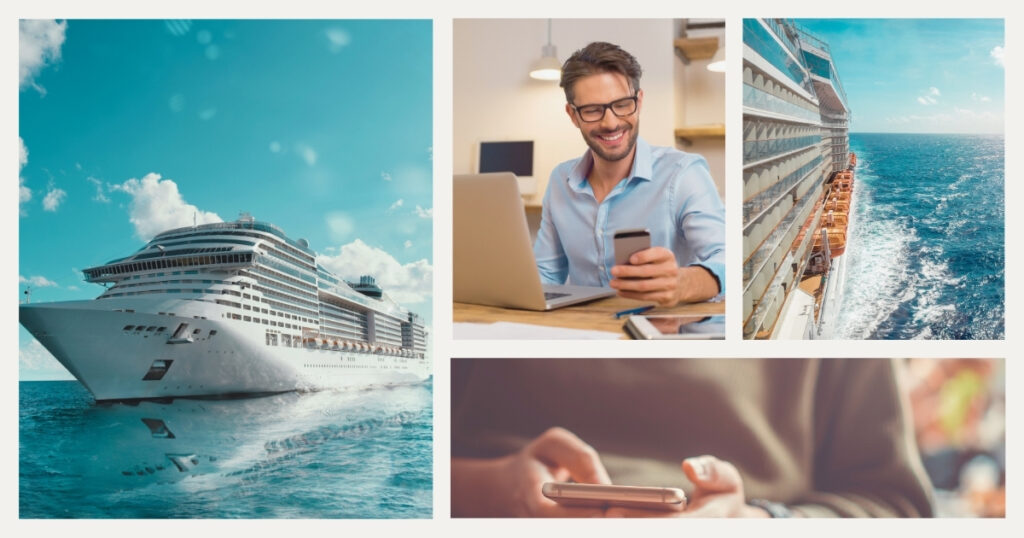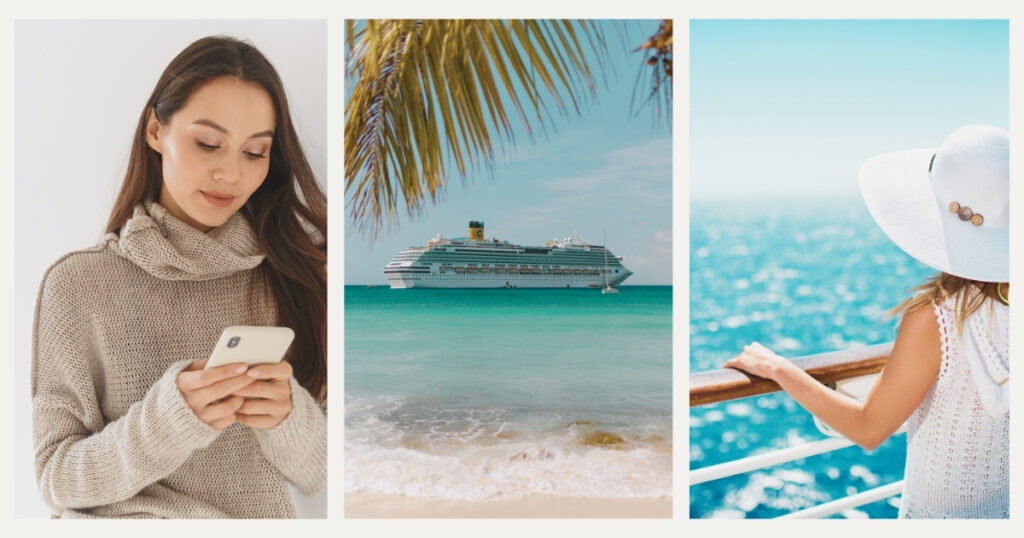Working as a digital nomad while cruising the open seas represents the ultimate freedom. Imagine answering emails with panoramic ocean views, joining video calls from different ports, and submitting deliverables while sailing between exotic destinations. But this dream quickly sinks without reliable connectivity. A cruise eSIM can be your lifeline, ensuring you maintain professional standards while embracing maritime adventure across different countries.
For remote professionals considering work from cruise ships, connectivity challenges can appear daunting. Traditional solutions like ship WiFi typically offer disappointing speeds at premium prices, while juggling physical SIM cards becomes a logistical headache. This guide explores how embedded SIM technology provides the perfect connectivity solution for digital nomads at sea.
Understanding cruise eSIM technology for digital nomads

Unlike traditional physical SIM cards, a cruise eSIM is built directly into your device, allowing you to activate cellular plans digitally without swapping physical cards.
For digital nomads onboard, this technology represents a significant advancement. As your ship navigates between different territorial waters and ports, your digital SIM seamlessly switches between networks, maintaining connectivity regardless of location. This eliminates the need to purchase new cards at each port or rely exclusively on expensive ship WiFi.
The latest devices from Apple (iPhone 11 or newer), Samsung (Galaxy S20 or newer), Google (Pixel 3 or newer), and many other manufacturers support this technology. Before departure, verify compatibility by checking your settings or manufacturer’s website.
🌟 Pro tip: many modern devices support using both a physical SIM and eSIM simultaneously, allowing you to maintain your home number while using your digital solution for data – perfect for staying professionally accessible while managing costs.
Key benefits of using cruise eSIM for digital nomads
This connectivity solution offers several distinct advantages for remote professionals at sea:
- Seamless transitions between countries as your vessel moves through different territorial waters without reconfiguring your device. This continuity is invaluable during important work tasks.
- Cost control through prepaid data packages that prevent surprising bills from international roaming. Most providers offer transparent pricing with no hidden fees.
- Multiple network access that connects to the strongest available signal from various cellular providers, significantly improving your experience compared to being locked to a single network.
- Easy activation entirely from your device, meaning you can purchase and set up new data plans even when approaching new territories with minimal connectivity.
💡 Did you know? Most maritime connectivity solutions can be activated before your trip and scheduled to begin service on your departure date, ensuring you’re connected immediately without wasting any data allowance.
Comparing top cruise eSIM providers for working at sea

The market for digital connectivity at sea has evolved rapidly. When evaluating providers, consider data allowances, coverage areas, and pricing structures that align with your work requirements and itinerary.
Each provider offers different strengths, so your optimal choice depends on your specific route, data needs, and budget. Here are the most reliable options for professional use at sea.
Global coverage solutions for ocean-going professionals
For cruises covering multiple regions, these providers offer extensive international coverage:
Holafly’s digital SIM solution offers unlimited data packages with coverage in over 170 countries, making it ideal for extensive journeys through multiple regions. Their plans range from 5 to 90 days, suitable for everything from short work retreats to extended voyages. The Holafly’s travel eSIM app provides straightforward activation, allowing you to monitor usage and purchase additional data as needed.
Airalo provides region-specific and global packages with competitive pricing and excellent network reliability across major destinations. Their “Discover Global” package covers over 100 countries with data packages ranging from 1GB to 20GB, perfect for moderate users.
GigSky focuses on pay-as-you-go flexibility with strong coverage in Mediterranean, Caribbean, and Southeast Asia destinations. Their service works exceptionally well in port cities and offers data rollover for unused amounts.
When selecting a provider, prioritize those covering both your port destinations and sea routes between them. This ensures connectivity not just when docked but also while sailing through territorial waters.
🌟 Pro tip: check if your provider offers a “port-only” or “land-only” package at a lower price if you plan to rely on ship WiFi while at sea and only need mobile data when in port.
Data plans optimized for remote work at sea
Digital nomads require plans that support professional activities like video conferencing, cloud-based work, and file transfers. Look for these features:
Regional specialists offering optimized packages for specific routes. For Caribbean journeys, operators like T-Mobile and AT&T provide enhanced data capabilities in popular island destinations.
Day-pass options from providers like Truphone that activate data only when approaching land or in port, maximizing budget efficiency for intermittent connectivity needs.
High-bandwidth packages from specialized providers with optimized settings for professional applications, ensuring meetings don’t drop and cloud uploads complete successfully even with variable signal strength.
When selecting a work-optimized plan, consider your typical data consumption. Video calls use 500MB-1GB per hour, while cloud syncing might require several GB. Choose a plan with enough capacity for your busiest workdays.
💡 Did you know? Many providers now offer packages with prioritized bandwidth for work applications like Zoom, Teams, and Slack, ensuring these critical services receive preference when network capacity is limited.
Setting up your cruise eSIM for optimal work performance

Proper configuration can dramatically improve your work experience at sea. Beyond simple activation, these optimization steps ensure reliable connectivity for professional tasks.
Device preparation and installation
Before departing, complete these essential setup steps:
- Update your device operating system to the latest version, as support improves with newer updates.
- Verify your device is unlocked for international use by contacting your home carrier.
- Install your chosen provider’s app before your trip, as you’ll need it for activation.
- Test activation while still on land, ensuring everything works before setting sail.
The installation process varies slightly between iPhone, Android, and other devices, but typically involves scanning a QR code or downloading the profile through the provider’s app.
Network configuration for reliable connectivity
Once installed, optimize these settings for the best experience:
Configure your APN settings according to provider instructions, as incorrect settings can cause significantly slower speeds or connection failures.
Set data roaming to “on” for your profile, required for international connectivity, but consider setting usage alerts to monitor consumption.
Enable network selection to “automatic” to ensure your device switches between available networks as your ship moves through different territories.
For devices supporting dual SIM mode, prioritize your travel profile for data while keeping your home SIM active for voice calls.
🌟 Pro tip: create a “Work Mode” shortcut that automatically optimizes all settings when you need to handle important professional tasks, then switches to conservative settings when not working.
Connectivity strategies for digital nomads on different cruise types

The connectivity experience varies significantly depending on your cruise type, route, and seas. Tailoring your approach ensures you’re never caught without essential connectivity.
Caribbean and mediterranean cruise connectivity
These popular regions offer excellent cellular coverage near islands and coastal areas:
Caribbean itineraries benefit from strong infrastructure across major islands, with signals often extending several miles offshore. Mobile data typically provides reliable service when approaching Jamaica, the Bahamas, and Puerto Rico, with shorter gaps between destinations.
Mediterranean routes offer near-continuous coverage along coastal areas, with European networks extending well into the sea. Countries like Italy, Greece, and Spain maintain excellent cellular systems that travelers can leverage without interruption in most areas.
For these regions, a multi-country package usually provides the most cost-effective solution as you’ll cross numerous territorial waters.
Transatlantic and transpacific connectivity challenges
For ocean crossings, connectivity requires strategic planning:
During sea days, prepare for limited or no cellular service in international waters. Schedule work accordingly, focusing on offline tasks during these periods and planning online activities for approaches to port.
Use territorial water approaches efficiently, as you’ll typically begin receiving signals 12-20 miles from shore. These windows provide opportunities to sync emails, upload work, or conduct essential communications.
Consider supplementing with limited ship WiFi purchases for emergency connectivity during extended crossings where no cellular service exists.
💡 Did you know? Experienced sea-based digital nomads often schedule their work calendar around their ship’s itinerary, allocating research and content creation to sea days while scheduling client calls and collaborative sessions for port days.
Practical tips for working efficiently with a cruise eSIM

Beyond technical aspects, successful remote work at sea requires strategic connectivity management. These practical approaches help maximize productivity while managing data consumption.
Data conservation techniques for limited connectivity
Implement these strategies to optimize your data allowance:
Download essential files, reference materials, and communication threads before sailing or when connected to port WiFi, enabling offline work when necessary.
Configure cloud applications for manual syncing rather than automatic updates, giving you control over large data transfers.
Use compression tools and browser extensions that reduce bandwidth consumption for web applications.
Schedule data-intensive tasks for port days when you can supplement with free WiFi from cafes or co-working spaces.
🌟 Pro tip: create a “port day productivity routine” where you maximize connectivity by updating software, backing up work, and handling data-intensive tasks while enjoying reliable land-based connections.
Maintaining professional standards with variable connectivity
Even with reliable service, maritime connectivity varies. These approaches help maintain professional standards:
Communicate your cruise schedule to clients or colleagues in advance, setting appropriate expectations about your availability.
Develop contingency protocols for important deadlines, such as having a trusted colleague who can handle emergency submissions if you encounter connectivity issues.
Use email autoresponders with information about your limitations and alternative contact methods for urgent matters.
Consider time zone changes when scheduling communications, as your journey may cross multiple zones that affect synchronous work requirements.
These strategic approaches create a sustainable remote work environment that complements rather than compromises your maritime adventure.
Final thoughts on cruise eSIM solutions for digital nomads
Working remotely from cruise ships represents a special freedom – exploring multiple destinations while maintaining professional commitments. Digital connectivity bridges the gap between maritime adventure and work requirements, making this lifestyle increasingly viable.
As cruise lines expand their routes and providers enhance coverage, the possibilities for sea-based digital nomads continue to grow. By selecting the right connectivity solution, optimizing device settings, and implementing strategic work practices, you can balance professional responsibilities with the unparalleled experience of working from breathtaking seascapes.
Ready to set sail while staying connected? We can help you prepare for your working cruise adventure. From technology solutions to productivity strategies for unconventional workspaces, we’ve got you covered.
Need more guidance on balancing adventure with professional responsibilities? Chart your course with Nomada 👉
Frequently asked questions about cruise eSIMs
This technology primarily works in territorial waters (generally within 12-20 miles of coastlines) and at ports. In the open ocean, you’ll typically rely on ship WiFi. Your service will automatically reconnect when approaching land or entering territorial waters included in your coverage plan.
Yes, multi-country packages are specifically designed for travelers visiting multiple destinations. Providers like Holafly cover 170+ countries, ideal for cruises with diverse ports of call. Always verify that your specific destinations are included in your selected package.
For most digital nomads, a combination works best. Ship WiFi provides connectivity in international waters but is often slow and expensive. Mobile data offers faster, more reliable, and typically more affordable connectivity when near land or in port. Professional remote workers generally use ship WiFi for basic connectivity at sea and rely on cellular service whenever in range of networks.
Most modern smartphones (iPhone 11+, Samsung Galaxy S20+, Google Pixel 3+) support this technology. Check your device settings under “Cellular” or “Mobile Data” for eSIM options, or consult your manufacturer’s website. When purchasing, confirm the provider supports your specific model.




